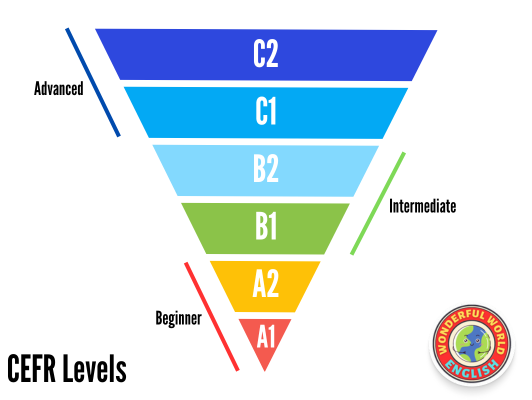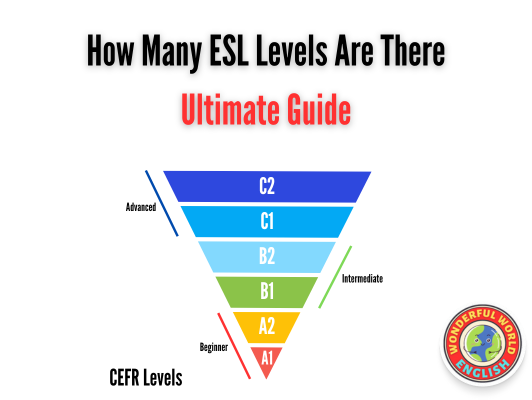Contents
Toggle
Meet David De’ Ath, founder, editor, and writer at Wonderful World English. With his extensive background as an English teacher, David provides valuable insights and practical tips on ESL for students and teachers alike.
When learning English as a Second Language (ESL), students progress through various proficiency levels.
These levels are designed to assess and categorize a learner’s command of the language.
The most recognized framework for these levels is the Common European Framework of References for Languages (CEFR).
The CEFR splits language proficiency into six key levels, starting from A1 for complete beginners, to C2 for those who have mastered the language.
This structure helps learners and teachers to identify current ability and plan the next steps in the learning journey.
Understanding these levels is important for both language learners who want to track their progress and institutions that set the learning standards.
The levels are often used to develop curriculum, create standardized tests, and even by employers to assess language skills.
For learners, knowing these levels can guide them to appropriate learning materials and courses that match their current understanding of the language.
Key Takeaways
- ESL levels are categorized into a clear framework, aiding learners in progression.
- The CEFR provides six levels to describe language proficiency from beginner to mastery.
- Knowing one’s ESL level helps in selecting suitable learning resources and measuring improvement.
Understanding ESL Levels and the CEFR
The Common European Framework of Reference for Languages outlines a scale of language ability from A1 for beginners, up to C2 for those at a high level of proficiency.
This framework is used worldwide to describe language skills.
Origins and Overview of the CEFR
The CEFR was developed by the Council of Europe to provide a comprehensive and transparent system for assessing and teaching European languages.
Introduced in the 1990s, its aim was to ensure a uniform standard for language learners and educators across Europe, although it has since gained international recognition.
The framework enables language learners, teaching professionals, and educational institutions to gauge and compare language proficiency levels.
Breakdown of CEFR Levels
The CEFR divides learners into three broad divisions which are further broken down into six levels:
- Basic User
- A1: Beginner
- A2: Elementary
- Independent User
- B1: Intermediate
- B2: Upper-intermediate
- Proficient User
- C1: Advanced
- C2: Proficient
At the A1 level, individuals can understand and use everyday expressions and very basic phrases.
Moving up to A2, users can communicate routine tasks and describe aspects of their background with simple language.
B1 level learners can handle travel and work-related language situations, while B2 learners can engage in technical discussions within their field.
At the C1 levels, users proficiently navigate complex subjects and articulate ideas well.
Lastly, those at C2, the pinnacle of the CEFR Levels, can understand virtually everything heard or read and can express themselves spontaneously at the level akin to a native speaker.

Applying ESL Levels to Language Skills
English as a Second Language (ESL) levels provide a structured framework that gauges and promotes language abilities across key areas: reading, listening, speaking, and writing.
Understanding and utilizing these levels can profoundly affect one’s journey to language mastery.
Language Skills Assessed by ESL Levels
Reading and Listening: ESL levels assess a learner’s capacity to understand written and spoken information. At the lower levels, individuals might only grasp the basic meanings of sentences, while at higher levels, they interpret complex texts and comprehend detailed conversations.
- A1-A2 (Basic User): Learners recognize familiar words and understand simple phrases.
- B1-B2 (Independent User): They grasp the main points of clear standard speech and can read texts on familiar topics.
- C1-C2 (Proficient User): They understand long and demanding texts, recognize implicit meaning in conversation, and listen to lectures and presentations with minimal effort.
Speaking and Writing: ESL levels evaluate an individual’s production and interaction in English. Basic users can introduce themselves and write simple, short texts. As proficiency heightens, these speakers debate various topics fluently and write well-structured, detailed compositions.
- A1-A2: Can interact in a simple conversation and write brief, connected text on familiar subjects.
- B1-B2: Capable of producing text on a wide range of topics, and can engage in conversation spontaneously.
- C1-C2: Convey ideas with precision, create sophisticated written content, and use language flexibly for social, academic, and professional purposes.
Improving Language Proficiency Through ESL Levels
To improve language proficiency, learners should focus on expanding their vocabulary and grammar skills appropriate to their ESL level.
Targeted practice enhances both fluency and accuracy.
- Grammar and Vocabulary:
- Basic levels introduce essential grammar and frequent vocabulary terms.
- Intermediate levels demand more complex grammatical structures and broader vocabulary.
- Advanced levels challenge with idiomatic expressions and precise lexical choices.
- Fluency and Mastery:
- At lower levels, fluency is about navigating simple conversations.
- Intermediate learners work towards more fluid speech and writing.
- Advanced students aim to achieve a degree of mastery that allows effective communication in a variety of contexts.
Practical strategies to enhance language abilities include:
- For reading, exploring diverse materials from news articles to classic literature.
- Listening enhancement comes from consuming multimedia in English, such as movies, podcasts, and lectures.
- To polish speaking, engaging in discussions with native speakers or in language exchanges is crucial.
- Advancing writing skills involves crafting essays, reports, and creative writing, along with seeking feedback.
Language learning is an ongoing process, and ESL levels serve as milestones to guide learners toward linguistic proficiency.
Each stage demands focused practice on the four key language skills, thus ensuring steady progression towards fluent and accurate English communication.
If you would like to take our FREE English proficiency test based on the CEFR framework, click the link below!
Take Our Free English Test and Discover Your Level!

Resources and Testing for ESL Learners
When exploring ESL education, learners have access to various standardized tests and a plethora of learning materials.
These resources are crucial for assessing proficiency and guiding study plans.
Standardized English Proficiency Tests
Various standardized English proficiency tests are recognized internationally to assess ESL learners’ language skills.
Among them is the International English Language Testing System (IELTS), which evaluates English proficiency across four skills: listening, reading, writing, and speaking.
The Test of English as a Foreign Language (TOEFL) is another widely accepted test used by academic institutions to judge the English skills of prospective students.
The Cambridge English exams offer a range of targeted tests for different levels and purposes.
For those in the business field, the Business Language Testing Service (BULATS), which has been absorbed into Cambridge’s Linguaskill test, and the Test of English for International Communication (TOEIC) are tailored to measure English communication skills in a professional context.
The British Council’s Aptis test is a flexible English assessment tool used by organizations to benchmark English language levels.
Pearson’s Global Scale of English (GSE) is a standardized, granular scale that measures English language proficiency more precisely than traditional methods.
Learning Materials and Courses
ESL learners might choose from a variety of learning materials and courses to improve their English language ability.
Traditional resources include textbooks, grammar guides, and worksheets.
However, online courses and digital resources have become increasingly popular, providing flexible study options.
British Council and other institutions often offer free or paid courses that align with English levels according to the CEFR, offering structured learning paths.
The CEFR levels, ranging from A1 for beginners to C2 for mastery, are a common way to describe a learner’s prowess.
Study plans using these resources can be tailored to individual needs, whether for self-study or guided instruction.
It’s vital for ESL learners to select materials that suit their specific placement test results and learning objectives.
The ongoing evolution of language learning frameworks amplifies the accessibility and variety of ESL levels and study materials.
If you’re looking for a place that offers proper support, courses, materials, connections, and so much more, join our Skool community!
Click the link below to find out more!

Practical Advice for ESL Students and Teachers
Mastering English as a second language involves structured study plans and teaching strategies that address the varying levels of language proficiency.
Both students and teachers can benefit from approaches tailored to specific ESL levels, ensuring effective learning and teaching experiences.
Tailoring Study Plans to ESL Levels
Students learning English face a spectrum of challenges depending on their starting point.
A well-crafted study plan should consider the student’s current level, which is often best determined by a placement test.
- Beginners: For those at the starting line, focusing on basic phrases and grammar structures is vital. Learning materials should include visual aids and simple texts to build a foundation.
- Intermediate: Students at this stage should expand their vocabulary and work on more complex grammar. Real-world materials like articles and videos can be beneficial.
- Advanced: Those nearing proficiency should refine their language skills, aiming to understand the nuances and idioms used by native English speakers. Practice with advanced literature and in-depth discussions helps bridge the threshold to fluency.
It’s important for each student to have a personalized study plan that aligns with their goals and incorporates a range of learning materials.
ESL Teaching Strategies for Various CEFR Levels
Teachers can utilize a diverse set of strategies to cater to different levels of the CEFR, which is a widely used system that describes language ability.
- A1-A2 (Basic User): Use objects, pictures, and simple sentences to teach new words and phrases. Encourage students to engage in role-play activities to practice everyday conversations.
- B1-B2 (Independent User): Introduce more complex tasks that require the use of English in practical situations. Focus on improving listening and speaking skills through group work and class discussions.
- C1-C2 (Proficient User): Challenge students with debates, presentations, and essay writing to enhance their advanced English abilities. Encourage reading of challenging materials and listening to native speaker content for subtlety and context.
Throughout these levels, teachers should offer tips and advice on effective study habits, resources for practice, and how to overcome common challenges in learning English.

Conclusion
Understanding ESL levels through the Common European Framework of Reference for Languages (CEFR) provides a clear and structured path for both learners and educators.
This framework, ranging from A1 for beginners to C2 for those mastering the language, helps in identifying language proficiency, setting realistic goals, and selecting appropriate learning materials.
For students, it offers a roadmap to track progress and improve their language skills systematically.
For teachers, it provides a guide to tailor their teaching strategies to meet the specific needs of their students.
By leveraging this comprehensive system, both learners and educators can achieve effective and measurable outcomes in their ESL journey.
We hope you find value in this information; you can contact us if you require any support.
Have a wonderful day!





